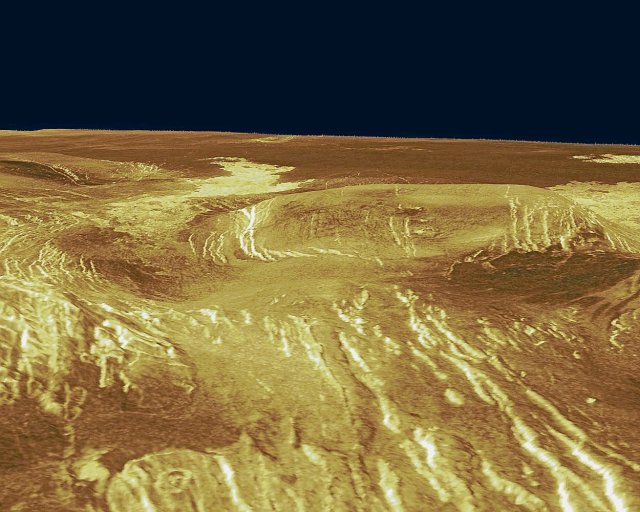Hot and extremely dry: the surface of Venus
Photo: nasa
While you can enjoy water in various physical states in many places on Earth, it is almost completely absent on neighboring Venus. In addition, on Venus, which is slightly smaller and lighter, there is more deuterium, heavy hydrogen, which also contains a neutron in its atomic nucleus, than can be explained by the relative abundances in the solar system. In short: Venus’ hydrogen balance has been a mystery so far.
New studies show that a previously overlooked chemical process could be responsible for the loss of atmospheric water or hydrogen from Venus.
In order to escape the gravitational field of a body, the speed of an object must be greater than its so-called escape velocity – this applies to rockets as well as to gas particles. Gravity holds back heavy atoms and molecules more strongly than lighter ones. On planets, a variety of processes contribute to the loss of atmospheric gases: Thermal processes, for example, heat the atmosphere and thus increase the kinetic energy and speed of the particles. Through photochemical processes, molecules can be changed, for example broken down, in such a way that lighter individual components can escape.
Deuterium indicates former water deposits
The fact that Venus must once have been significantly wetter can be deduced from the abundance of deuterium: Since the ratio of hydrogen to deuterium is largely the same in the solar system, the current amount of deuterium can be calculated from the former total amount of hydrogen – and with it water – close.
Based on these estimates, a very similar picture emerges for Venus and Earth: If the calculated or real water reserves were poured onto the planet’s surfaces regardless of all geological conditions, an ocean spanning 2.6 kilometers deep on Earth and even three kilometers deep would result of Venus. But while Earth dwellers can still dive and drink, there is drought on Venus. Today, their entire water supply would be just an ocean puddle a few centimeters deep.
Explanatory approaches assume that the water supply once lay in a dense haze around Venus – evaporated by the intense solar radiation that the planet’s proximity to the sun brings with it. The thermal and non-thermal processes eroded the atmosphere over time, with the light hydrogen compounds always disappearing a little faster than those with deuterium.
However, it turned out that the processes considered so far cannot adequately explain today’s atmospheric water shortage. The processes can “take” large amounts of water from the planet – but once a certain amount is reached, it stops. Venus should therefore have retained a layer of water ten to 100 meters deep.
Chemical process that has not been taken into account so far
The new study has now shown that a crucial process that contributes to the loss of hydrogen has not been taken into account in previous models. In “dissociative recombination,” a positively charged polyatomic ion captures an electron, the resulting neutral molecule splits and dissociates. In the case of Venus’ atmosphere, a formyl cation, HCO+, splits into carbon monoxide and hydrogen. The latter can now escape Venus without any problems – simple hydrogen is always a little better than deuterium.
In the new model calculations that take this process into account, twice as much hydrogen escapes as in previous models – which is in good agreement with the time scales of water loss on Venus.
So far, the formyl cation has flown under the observation radar: several Venus probes, including the two Pioneer Venus probes and Venus Express, carried out spectroscopic studies of the atmosphere, but the instruments were not designed to detect the compound. Future missions such as Davinci or Veritas could provide a solution with expanded detectors to check the new models through measurements.
#ndstays – Get active and order a promotional package
Regardless of whether it is pubs, cafés, festivals or other meeting places – we want to become more visible and reach everyone who values independent journalism with an attitude. We have put together a campaign package with stickers, flyers, posters and buttons that you can use to get active and support your newspaper.
To the promotional package
